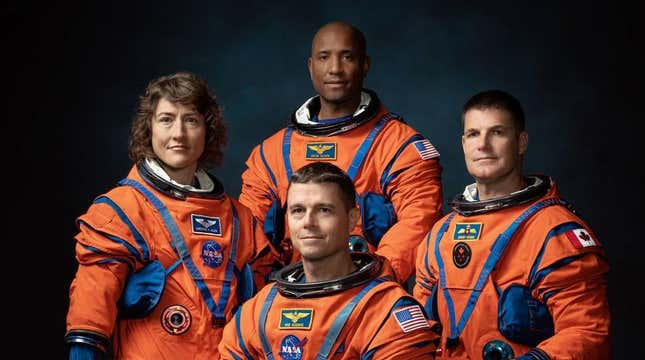
NASA and the Canadian Space Agency introduced the crew of the Artemis II mission Monday just outside of NASA’s Johnson Space Center in Houston. The three Americans and one Canadian represents humanity’s first return to the Moon since the Apollo 17 mission in 1972.
From NASA’s press release:
“The Artemis II crew represents thousands of people working tirelessly to bring us to the stars. This is their crew, this is our crew, this is humanity’s crew,” said NASA Administrator Bill Nelson. “NASA astronauts Reid Wiseman, Victor Glover, and Christina Hammock Koch, and CSA astronaut Jeremy Hansen, each has their own story, but, together, they represent our creed: E pluribus unum – out of many, one. Together, we are ushering in a new era of exploration for a new generation of star sailors and dreamers – the Artemis Generation.”
The crew assignments are as follows: Commander Reid Wiseman, Pilot Victor Glover, Mission Specialist 1 Christina Hammock Koch, and Mission Specialist 2 Jeremy Hansen. They will work as a team to execute an ambitious set of demonstrations during the flight test.
This flight crew, scheduled to take part in the approximately 10-day flight in late 2024, would make Victor Glover the first Black astronaut to orbit the moon. Christina Koch will become the first woman to do so, and Jeremy Hansen will become the first Canadian onboard a lunar mission. Each member brings many years worth of experience and expertise:
This will be Wiseman’s second trip into space, serving previously as a flight engineer aboard the International Station for Expedition 41 from May through November 2014. Wiseman has logged more than 165 days in space, including almost 13 hours as lead spacewalker during two trips outside the orbital complex. Prior to his assignment, Wiseman served as chief of the Astronaut Office from December 2020 until November 2022.
The mission will be Glover’s second spaceflight, serving previously as pilot on NASA’s SpaceX Crew-1, which landed May 2, 2021, after 168 days in space. As a flight engineer aboard the space station for Expedition 64, he contributed to scientific investigations, technology demonstrations, and participated in four spacewalks.
Koch also will be making her second flight into space on the Artemis II mission. She served as flight engineer aboard the space station for Expedition 59, 60, and 61. Koch set a record for the longest single spaceflight by a woman with a total of 328 days in space and participated in the first all-female spacewalks.
Representing Canada, Hansen is making his first flight to space. A colonel in the Canadian Armed Forces and former fighter pilot, Hansen holds a Bachelor of Science in space science from Royal Military College of Canada in Kingston, Ontario, and a Master of Science in physics from the same institution in 2000, with a research focus on Wide Field of View Satellite Tracking.
Artemis I flew unmanned in November of last year and, despite a few launch challenges like leaky fuel tanks and hurricanes, flew a successful 25-day, 1.4-million-mile mission, mainly testing life support systems for the Artemis II flight. As of right now, Artemis I is the farthest a vessel meant for manned spaceflight has traveled in human history. The Artemis II mission will further test life-support systems as well as new ways of living and working in deep space. What Artemis II won’t do, however, is put boots in the dust. Actual touchdown on lunar surface will need to wait for Artemis III, scheduled for 2025.
